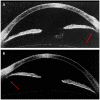Bilateral Angle Recession and Chronic Post-Traumatic Glaucoma: A Review of the Literature and a Case Report
- PMID: 37763218
- PMCID: PMC10532958
- DOI: 10.3390/life13091814
Bilateral Angle Recession and Chronic Post-Traumatic Glaucoma: A Review of the Literature and a Case Report
Abstract
Ocular trauma affects millions of people worldwide and is a leading cause of secondary glaucoma. Angle recession is the main cause of post-traumatic glaucoma after blunt eye trauma, and it is usually unilateral. The aim of this paper is to investigate the possible causes of angle recession with a bilateral presentation. Airbag activation during traffic accidents is a likely cause to be ruled out, along with repeated head or eye trauma, due to contact sports or a history of physical abuse. These aspects can aid in early detection, appropriate management, and improved outcomes for patients with ocular trauma. Finally, we report the case of a 75-year-old Caucasian man who developed a bilateral angle recession after an airbag impact, with advanced glaucoma in the right eye and ocular hypertension in the left eye. To our knowledge, this is the first case in the literature of chronic post-traumatic glaucoma probably caused by an airbag.
Keywords: airbag eye injuries; angle recession; bilateral eye injuries; post-traumatic glaucoma.
Conflict of interest statement
The authors declare no conflict of interest.
Figures





References
-
- Ng S.M.S., Low R., Hoskin A.K., Rousselot A., Gunasekeran D.V., Natarajan S., Sundar G., Chee C.K.L., Mishra C., Sen P. The application of clinical registries in ophthalmic trauma—The International Globe and Adnexal Trauma Epidemiology Study (IGATES) Graefes Arch. Clin. Exp. Ophthalmol. 2022;260:1055–1067. doi: 10.1007/s00417-021-05493-6. - DOI - PubMed
-
- Pieramici D.J., Sternberg P., Jr., Aaberg T.M., Sr., Bridges W.Z., Jr., Capone A., Jr., Cardillo J.A., De Juan E., Jr., Kuhn F., Meredith T.A., Mieler W.F., et al. A System for classifying mechanical injuries of the eye (Globe) Am. J. Ophthalmol. 1997;123:820–831. doi: 10.1016/S0002-9394(14)71132-8. - DOI - PubMed
Publication types
LinkOut - more resources
Full Text Sources
